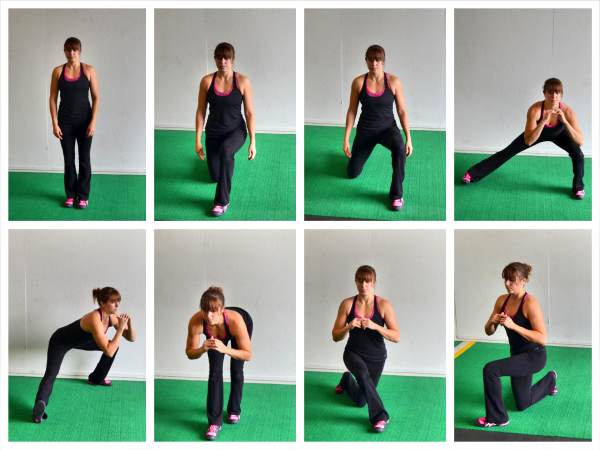Our bodies should be able to move in every direction, yet our workouts rarely, if ever, include movements in every direction.
When we lunge, we tend to lunge forward and backward only. With maybe a side lunge or two thrown in there.
But we should be lunging in every direction so we can MOVE in every direction in daily life without getting injured.
The whole point of working out is to make our bodies more mobile and stronger so we can live pain free.
That is why you need to include the lunge matrix in your workout routine!
The lunge matrix moves your body in every direction. It strengthens your legs and your glutes in every plane since you are lunging in every direction.
It makes you functional strong to prevent injury!
Lunge Matrix Form:
The easiest way to remember all the lunges is to think about lunging around a clock. Start facing “12″ on the clock. Doing all the lunges first moving the left foot…

- Front Lunge: Step the left foot forward and sink down into a front lunge. Bend both the front and back knees. Make sure you do not lean forward as you lunge forward. Also make sure you drive off your front heel to push back to standing.
- Angled Front Lunge: After returning to standing after the front lunge, you will again lunge forward, but this time out at an angle. Lunge forward toward “11″ on the clock with your left foot. Bend both your back and front knees as you lunge forward, keeping both toes pointing straight ahead. Then drive off your left heel to come back to standing.
- Side Lunge: Again lunging with the left foot, step the left foot out toward “9″ on the clock. As you lunge out to the side, you are going to bend the left knee and sit your butt back. Keep your right leg straight. Both toes should be pointing straight ahead. Keep your leftt heel down as you sink into the lunge. Push your butt back and keep your chest up. Then drive back up to standing.
- Backward Rotational Lunge: Next you will lunge back toward “7″ on the clock with your left foot. Your left foot, when you step back, will be perpendicular to your right foot, which is pointing toward “12.” Push your butt back and sink into a lunge, bending the left knee while keeping the right leg straight. Do not let the left heel come up. Keep your chest up and sit your butt backward. Driving off your left heel, push back to standing. Make sure that your right toe doesn’t rotate but continues to point toward “12.” Also make sure your right leg does not bend.
- Backward Hinge: Again moving the left foot, step your left foot back so that the toe is even with the heel of your right foot. Both toes will point toward “12.” After taking the little step back, you are going to hinge over at the hips, pushing your butt back toward the wall behind you. You will feel a stretch down your hamstrings. Then stand back up and step forward.
- Curtsy Lunge: Take your left foot and step your left foot back behind your right leg. You will reach your left foot back to about “5″ on the clock. Make sure you step far enough back (do not keep your left foot too close to your right) that you can bend both knees and sink down into a deep lunge. Keep your right heel down on the ground and your chest up. Then come back to standing. Make sure that you feel this lunge in the outside of your right butt cheek when you lunge back with the left leg.
- Forward Cross Lunge: Lunge forward and across toward about “2″ on the clock with your left foot. Pivot your left foot so that your feet are perpendicular. Sink down into a lunge, bending both knees. Make sure your left heel stays down as you lunge. Then drive off your left heel to come back to standing.
You can do the lunge matrix as a whole or break the lunge matrix up into sets of two or even three lunges. You can even choose a single lunge to do in isolation. The front lunge and reverse lunge aren’t the only two lunges that can be done on their own!
You can also do the full matrix with a Reverse Lunge instead of the Backward Hinge if you want to mix things up.
Modifications:
Beginners will not want to sink as deep into the lunges as a more advanced exerciser. They will also want to take shorter steps out to the lunge to help them keep it shallow. Make sure that however far you lunge out, you can easily push straight back to center. Don’t lunge out so far that you struggle to get back up.
Advanced exercisers will want to add in arm drivers (reaching up, down, left and right) or even a light, front-loaded weight.
Below is an example of arm drivers:





Thanks for this fabulous resource, Cori! I’m trying to build up my running but have lots of niggles and these are going to help resolve them.
Just wanted to share these fabulous warm up moves too – https://youtu.be/QGEexDjtdSY